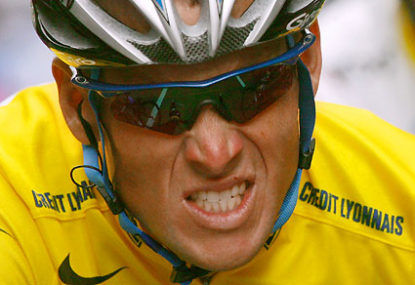'I've just won a stage of the Tour de France, mate!': Hindley grabs yellow jersey as Aussie blows Tour apart
Australia's Jai Hindley has said he is "lost for words" after a shock stage victory at the Tour de France earned him the leader's…

It’s clear a lot of people in the Lance Armstrong doping scandal have not escaped with a clean reputation. Yet if there’s one party without blame, it’s the South Australian government.
That sentence seems so obvious as to be a non-sequitur – why the hell would an Australian state government even be brought up in the same story as a man from the USA who won seven bike races in France?
Well apparently Lance competing in the Tour Down Under from 2009 – 2011, having been paid an appearance fee by the South Australian government, makes Mike Rann’s government if not as implicit as Dr Michele Ferrari, at least as suspicious as Hein Verbruggen.
This week Michael Ashenden, an anti-doping expert who was integral in implementing the UCI’s biological passport system, got stuck in to the Tour Down Under for “prostituting itself” by paying Armstrong an estimated $3 million (and possibly as much as $9 million) in appearance fees at the TDU.
“It will be known forever as the race who paid a serial liar millions of dollars to promote itself. It was poor judgment, backed up by poor governance in failing to guard against risks, which has now made the Tour Down Under infamous rather than famous.”
Ashenden might have been better served holding his tongue until having seen the opening stage of the 2013 TDU before he declared the race infamous rather than famous.
Were the tens of thousands of people who lined the streets of Adelaide to watch Andre Greipel take a record 12th stage victory at the TDU there because they regard the race as the Ned Kelly of World Cycling – the bad boy who pays outlaws to appear?
Or were they there to see the first race of the 2013 World Tour. A race which has grown dramatically in media coverage and the public’s estimation since 2009, when Armstrong first appeared?
To be fair to Ashenden, he acknowledged the publicity Armstrong brought to the race:
“On a business level, I don’t fault the government’s rationale, although I do consider their motives to be cynical.”
Cynical they may have been, but one can’t argue with the results.
Anyone who watches the TDU knows it is a fantastic race and one which stands on its own merits. But how many people actually watched the TDU prior to Armstrong’s maiden appearance?
One need only compare the television schedules.
In 2008, highlights of the TDU were broadcast on SBS. Last year Channel Nine attained the rights and this year Nine will broadcast ten hours of live racing – the most the TDU has ever had on free-to-air television.
While the quality of broadcast between SBS and Nine is debatable, the extra hours on free-to-air and the simple fact the race has moved from a government-subsidised network to one of Australia’s ‘big three’ shows the race has come along in leaps and bounds in a few short years.
Furthermore, since Armstrong’s 2009 appearance, the race has gone from being worth $17 million to $40 million to the SA economy.
And while Cadel Evans’ 2011 Tour de France victory and the 2012 introduction of the Australian Orica-GreenEDGE team to cycling have played their part in increasing interest in the TDU, to deny Lance Armstrong’s three years of participation helped grow the race is to bury one’s head in the sand.
Ashenden’s final dig – and the crux of his argument that the South Australian government should be taken to task for the successful growth of their flagship cycling race – was their lack of due diligence in investigating Armstrong.
“I do, however, fault their failure to conduct due diligence, for example by taking heed of the plentiful evidence available in 2009 indicating that Armstrong had doped. Due diligence should have prompted them to indemnify the event in case Armstrong brought the race into disrepute.”
In 2009 Armstrong was the ‘world’s most tested athlete’ and an inspiration to hundreds of millions around the globe. And while there had been accusations – some more credible than others – of doping levelled at the then-most successful Tour de France champion of all time, they had been just that, accusations.
Nothing had been proven and there were no officially recognised investigations in to Armstrong taking place. The Federal case against Armstrong (which was abandoned) was over a year away from being opened and the USADA’s Reasoned Decision was over three years away.
Furthermore, Lance had announced the 2009 TDU was to be the first race of his comeback, so the “one in a million” chance he wasn’t doping in his comeback couldn’t have been discovered at that point.
While the UCI has been criticised for allowing Armstrong to compete in an official race without having had a full six months of out-of-competition testing done, that was hardly the fault of the South Australian government.
So as far as they could reasonably ascertain, the TDU signed the greatest cyclist of all time in a major coup for cycling in Australia. What else they were supposed to have done with the facts presented to them?
As to Armstrong’s appearance at the 2010 and 2011 TDUs, one fact probably informed the SA government he was worth taking a punt of for those two years – the 138,000 people who turned up to see Armstrong compete in the 2009 prologue.
Simply put, Armstrong was the biggest draw-card the race had and, to date, has ever seen.
As such, the TDU and the SA government could, in fact, turn out to be the only clean winners in this whole dirty saga.